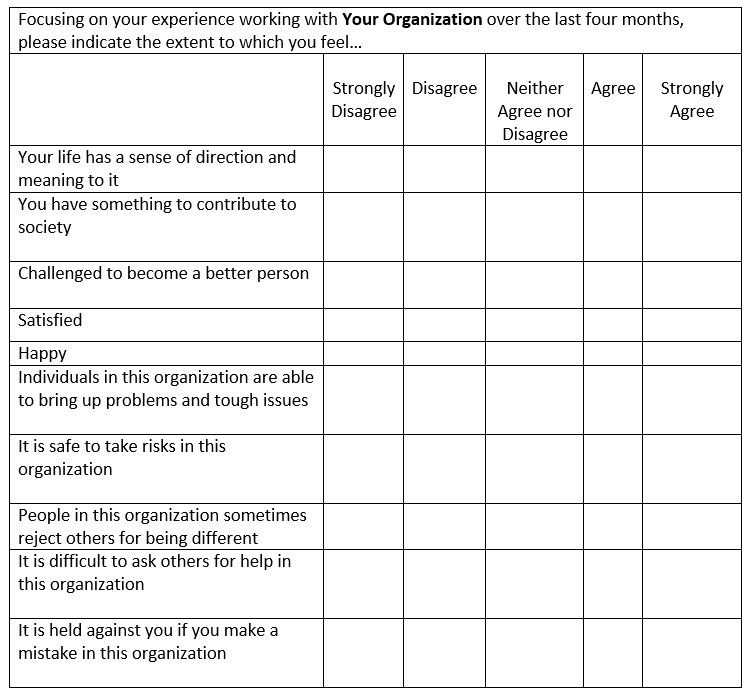SMU DataArts has added two additional questions to our Workforce Demographics Survey. These questions ask respondents to:
- Rate their level of well-being, happiness, and psychological safety at their workplace
- State how likely they are to recommend a similar position to a friend
These questions are intended to measure individuals’ sense of well-being and psychological safety in the workplace. We have added these questions to our survey to improve our ability to research how different forms of diversity in arts and cultural workplaces affect employee and organizational success.
Perception questions in the workforce demographics survey:

You can also
take an example workforce demographics survey, which includes the perceptions questions on the final page.
FAQ about perception questions Why are you asking these questions? SMU DataArts strives to collect data that is relevant to arts and cultural leaders and answers key research questions to help the sector thrive. In addition to better understanding the demographics of the arts and cultural workforce, we would like to increase understanding of the effects of workforce diversity on individuals and organizations. These questions will help researchers better understand the connections between diversity and perceptions of well-being in the arts and cultural workforce.
How were the questions developed? The questions are based on research about the different elements of wellbeing and psychological safety, and how they relate to job performance. We developed these questions
with our Donna Wilhelm Research Fellow, Dr. Daniel M. Cable, professor of organizational behavior at London Business School. The final question is
adapted for your workforce – your internal customers -- from the Net Promoter Score, which is a measure of customers’ overall perception of your brand. The questions have been piloted with staff from one organization and subsequently revised, and were used in the LA County Arts and Culture Workforce Demographics Survey.
Why measure well-being and psychological safety? People who believe their job has meaning and a broader purpose are more likely to work harder, take on challenging or unpopular tasks, and collaborate effectively.
Research repeatedly shows that people deliver their best effort and ideas when they feel they are part of something larger than the pursuit of a pay check.
When it comes to individual health, its best to score high on both types of well-being: hedonic, which refers to the quality of your experiences, and “eudemonic” happiness, which refers to the meaning or purpose you feel in life. But lots of people don’t score high on both. Four independent studies have revealed that it is far better for our immune systems when we score high on purposeful (eudemonic) happiness than hedonic happiness.
Psychological safety is the degree to which employees feel comfortable taking interpersonal risks. When an organization minimizes the fear people feel on the job, performance — at both the organizational and the team level — is maximized.
Research shows that achieving high performance requires having the confidence to take risks, especially in a knowledge-intensive world.
You can learn more about this in Daniel M. Cable’s 2018 book,
Alive at Work: The Neuroscience of Helping Your People Love What They Do. Who will see the answers to these questions? Like all of the questions collected in the workforce demographics survey, individuals’ responses to the perception questions are kept confidential and will not be shared with your organization or the study partner(s) who sponsored the study.
Organizations who have more than 10 employees and reach a sufficiently robust enough response rate to ensure confidence in the survey results, will receive a report about their organization at the end of the study. This report will include aggregated responses to the perception questions. The study partner may also have access to individual organizational reports. This way organizational leaders better understand workforce perceptions about well-being and sense of safety.
Responses to these perception questions will be used in the aggregate to inform a community report, as well as research into the connections between workforce diversity and employee wellbeing.

